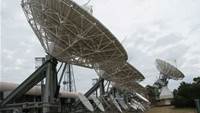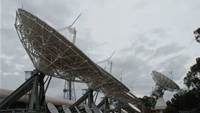Telecommunications carrier Optus has opened up the doors of its Sydney satellite earth station to iTnews as the company pitches satellite connectivity as a means of meeting the "last ten percent" requirements for the rollout of the Federal Government's National Broadband Network (NBN).
Optus claimed to be the only satellite operator in Australia that actually owns and operates its own fleet of satellites - with five satellites currently in orbit.
This satellite fleet provides much of the Pay TV and free to air broadcast services in Australia - including Foxtel, ABC and the SBS.
But it also provides mobile phone connectivity to remote Australian users via the 15-year old MobileSat and brand new Thuraya services; and satellite broadband services (VSAT) to 30,000 Australians using Federal Government ABG (Australian Broadband Guarantee) funding.
Optus has sent up four generations of satellites - the first in the mid to late eighties, the latest launch (D3) in August 2009 - giving it "one of the youngest fleets in the world."
Optus' sirector of Satellite Paul Sheridan told iTnews he expects to get 15 years of services from the latest D-series of satellites (until 2024).
The control rooms
During the tour, Sheridan first guided us through a satellite operations room, where technicians navigate both Optus satellites and third party satellites on behalf of the likes of Protostar and IntelSat. Unfortunately, photography was not allowed in this part of the facility.
The systems for driving the satellites (based on the Sun Solaris OS, incidentally) can be controlled using thin client technology from multiple earth stations - such that Perth, for example, could take over if the Sydney site went down. It is also from this room that Optus monitors the 10,000 or so telemetry points that measure the health and movement of the satellite.
From there, Sheridan took us to another monitoring facility where Optus ensures a continuous loop of signal in and out of the facility. From within this second room, Optus technicians can monitor as a broadcast is sent over the fibre network or microwave to the Sydney earth station, as it is beamed up to the satellite and back down to receiving dishes.
On deck
Optus' Sydney earth transmission station boasts a series of large dishes with either a fixed focused on geostationary satellites or tracking a satellite in incline [see photos top right].
Four of the five satellites (C1, D1, D2 and D3) Optus currently has in orbit are geostationary - sitting 36,500 km above the equator and travelling at a fixed speed (around 3km per second) such that from a single point on the equator, the satellite in orbit appears to be stationary.
These satellites all move within a fixed set of coordinates such that they can be picked up by fixed ground antennas without losing signal.
The B3 satellite, by contrast, is currently located at 164 degrees east and is "inclined" - meaning that it is no longer fixed and is monitored by a tracking antenna on the earth station.
Sheridan explained that this extends the life of the older satellite by conserving the fuel usually required to keep the satellite in a fixed position relative to earth.
The C1 and D3 satellites are used primarily for Foxtel and free to air television services in remote Australia (Aurora), D1 primarily for New Zealand's Pay TV equivalent and networking services in Australia such as VSAT, D2 is used for Sky Racing and international language Pay TV, while the inclined B3 satellite is used to back-up network elements such as Optus' fibre optic cables during the Victorian bushfires.
Launch support
Optus' Sydney satellite earth station is also used to provide support services for rocket launches.
Optus has now provided support services for 75 rocket launches - including the launch of ten of its own satellites and 65 for other satellite operators.
"When the satellite first comes out of the rocket, geographically Australia is often one of the first continents on earth to 'see' the satellite," Sheridan explained.
Sheridan was lucky enough to witness the launch of Optus' most recent satellite, the D3, in August 2009.
He explained that the Arianespace launch rockets are 50 metres tall, weigh 750 tonnes and are capable of launching two satellites from inside the nose cone on every launch.
From his viewing platform 14 kilometres away, Sheridan said he was warned he would "see it, hear it then feel it."
The site was spectacular, he said, the noise deafening, but it's the last sensation he won't forget.
"It's like being physically shaken," he said. "I'd like to do it a second time just to focus on that."







.png&h=140&w=231&c=1&s=0)





_(26).jpg&w=100&c=1&s=0)

 iTnews Executive Retreat - Security Leaders Edition
iTnews Executive Retreat - Security Leaders Edition












_(1).jpg&h=140&w=231&c=1&s=0)



